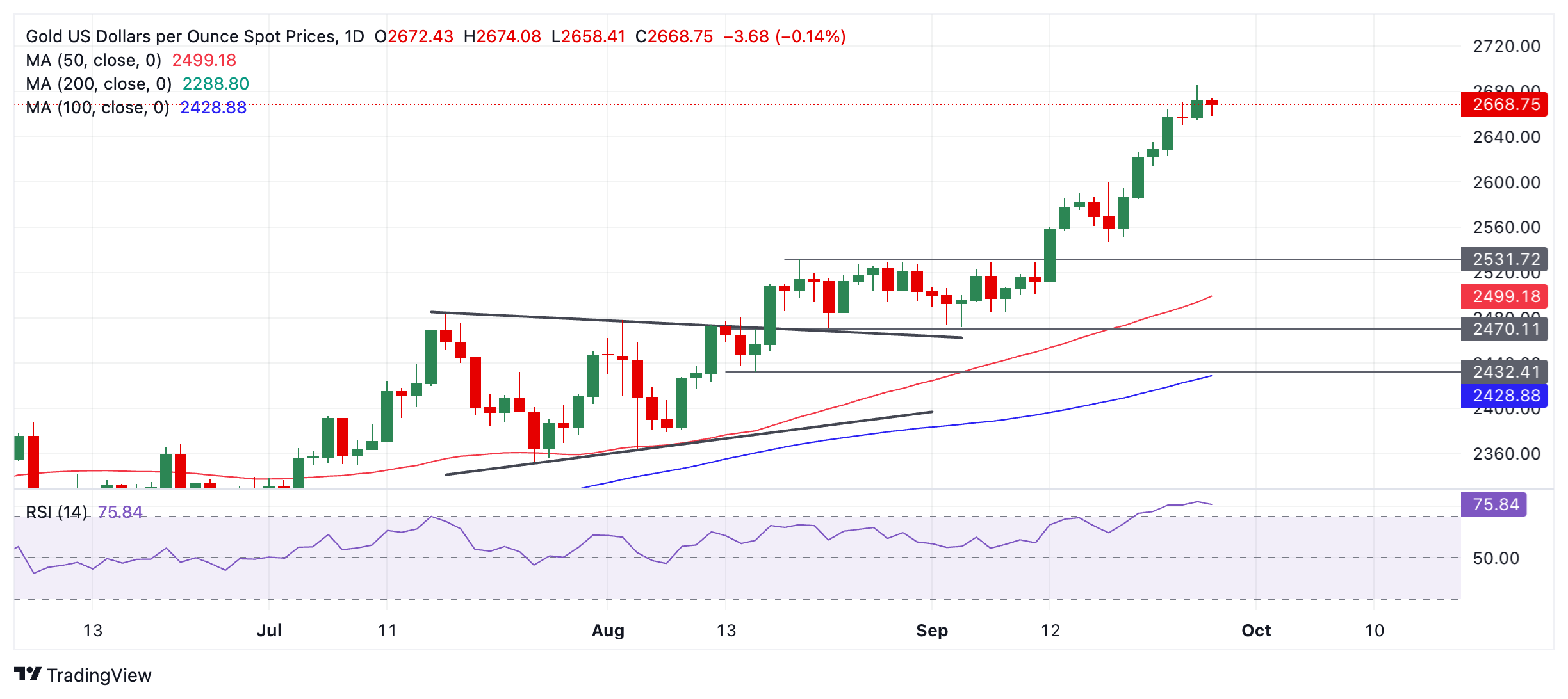- Gold rebounds at the end of the week after the release of US PCE inflation data comes out lower than expected.
- The data suggests a continuation of the Fed's monetary easing stance which is a positive factor for Gold.
- Gold price retreats as less dovish interest rate prospects and a stronger US Dollar are bearish.
Gold (XAU/USD) recovers to trade in the $2.660s per troy ounce on Friday after the release of US PCE inflation data fails to meet expectations. The disinflationary trend suggests the Federal Reserve (Fed) will continue to cut interest rates at a steady pace which is positive for Gold as a non-interest paying asset.
US Core Personal Consumption Expenditures (PCE) showed a 0.1% rise MoM in August, falling short of the 0.2% expected and the 0.2% reading in July, according to data from the US Bureau of Economic Analysis on Friday.
On an anualized basis Core PCE rose by 2.7% which was above the 2.6% in July and in line with estimates.
Headline PCE rose 0.1% MoM, which was below the 0.2% previous but in line with estimates. YoY headline PCE rose 2.2% which was lower than the 2.5% previous and 2.3% expected.
Gold had been edging lower prior to the data as the impact of Chinese government stimulus started to ebb and central banks globally seemed to be adopting a less dovish stance.
Gold stalls after making new record highs
Gold stalled after touching a new record high at the end of the trading week as the effect of the extra 1 trillion CNY of stimulus announced by the Chinese Politburo appears to have been priced in and central banks globally tend to adopt a less dovish stance. The Central Bank of Sri Lanka kept rates unchanged at their meeting, and the Swiss National Bank (SNB) and Bank of Mexico (Banxico) cut rates by only 25 bps. A recent Reuters poll, meanwhile, showed that the Reserve Bank of India (RBI) is expected to cut interest rates by a modest 50 bps over the next six months.
In addition, the expectation that the Fed would cut interest rates by half a percent at their meeting in November has eased after positive US macroeconomic data. US Initial Jobless Claims showed a decline to 218K in the week ending September 20, and the final estimate of Q2 Gross Domestic Product (GDP) growth remained in line with previous estimates at a fairly healthy 3.0% annualized. Further, US Durable Goods Orders beat estimates and overall recent data out of the US describes a soft landing for the economy that goes against market bets for aggressive monetary easing.
The probability of a 50 bps rate cut at the November Fed meeting has fallen back down to 50% from over 60% prior to the data, according to the CME FedWatch tool.
Gold may also be seeing reduced safe-haven flows as fears the conflict between Israel and Hezbollah might spill over into a ground offensive fail to materialize. Tensions remain high and a 21-day ceasefire deal put together by the Americans was rejected on Thursday. Houthi rebels in Yeman are also stepping up their attacks of shipping in the Red Sea which has left an Oil tanker reportedly adrift and abalze, according to AP News.
On Wednesday, the head of Israeli Defence Forces, Herzi Halevi, told his troops that they should prepare for a ground offensive on Lebanon. If such an invasion should take place, it would further ratchet up risk aversion and increase safe-haven flows into the yellow metal.
Technical Analysis: Gold pulls back from new all-time highs
Gold pulls back after hitting yet another all-time high of $2,685 on Thursday.
That said, it is overall still in an uptrend on a short, medium and long-term basis. Since it is a foundational principle of technical analysis that “the trend is your friend,” the odds favor even more upside for the yellow metal.
XAU/USD Daily Chart
Gold is also now overbought, according to the Relative Strength Index (RSI) momentum indicator, which increases the chances of a deeper pullback evolving. It also advises traders not to add to their long positions. If Gold exits overbought, it will be a sign to close long positions and sell shorts, suggesting an even deeper correction is in the process of unfolding.
That said, RSI can remain overbought for fairly long periods of time in a strongly trending market, and if Gold breaks to higher highs, it will further reconfirm the metal’s uptrending bias. The next targets to the upside are the round numbers $2,700 and then $2,750.
If a correction evolves, firm support lies at $2,600 (September 18 high), $2,550 and $2,544 (0.382 Fibonacci retracement of the September rally).
Economic Indicator
Core Personal Consumption Expenditures - Price Index (MoM)
The Core Personal Consumption Expenditures (PCE), released by the US Bureau of Economic Analysis on a monthly basis, measures the changes in the prices of goods and services purchased by consumers in the United States (US). The PCE Price Index is also the Federal Reserve’s (Fed) preferred gauge of inflation. The MoM figure compares the prices of goods in the reference month to the previous month.The core reading excludes the so-called more volatile food and energy components to give a more accurate measurement of price pressures. Generally, a high reading is bullish for the US Dollar (USD), while a low reading is bearish.
Read more.Tags: Featured,newsletter






























